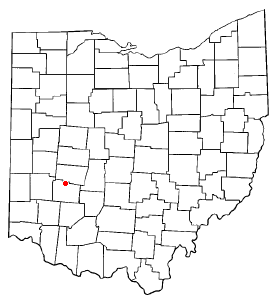Yellow Springs, Ohio
Yellow Springs is a village in Greene County, Ohio, and is the home of Antioch College. The population was 3,761 at the 2000 census, and was recorded at 3,665 in July 2005 (a -2.6% change).
Geography

Yellow Springs is located at 39°48′6″N 83°53′34″W / 39.80167°N 83.89278°WInvalid arguments have been passed to the {{#coordinates:}} function (39.801723, -83.892662)Template:GR.
According to the United States Census Bureau, the village has a total area of 4.9 km² (1.9 mi²), all land.
The village takes its name from a natural spring located in nearby Glen Helen Preserve, part of Antioch College, which is rich in iron ore, leaving a yellowish-orange coloring on the rocks. The spring was thought to have curative properties and spas and hotels were built nearby.
Demographics
As of the censusTemplate:GR of 2000, there were 3,761 people, 1,587 households, and 896 families residing in the village. The population density was 764.3/km² (1,981.3/mi²). There were 1,676 housing units at an average density of 340.6/km² (882.9/mi²). The racial makeup of the village was 76.58% White, 14.97% African American, 0.51% Native American, 1.49% Asian, 0.72% from other races, and 5.74% from two or more races. Hispanic or Latino of any race were 1.94% of the population.
There were 1,587 households out of which 24.8% had children under the age of 18 living with them, 40.4% were married couples living together, 13.2% had a female householder with no husband present, and 43.5% were non-families. 35.9% of all households were made up of individuals and 10.4% had someone living alone who was 65 years of age or older. The average household size was 2.11 and the average family size was 2.73.
In the village the population was spread out with 18.4% under the age of 18, 14.1% from 18 to 24, 23.5% from 25 to 44, 27.2% from 45 to 64, and 16.8% who were 65 years of age or older. The median age was 41 years. For every 100 females there were 80.0 males. For every 100 females age 18 and over, there were 73.1 males.
The median income for a household in the village was $51,984, and the median income for a family was $67,857. Males had a median income of $41,875 versus $37,744 for females. The per capita income for the village was $27,062. About 7.3% of families and 7.0% of the population were below the poverty line, including 11.2% of those under age 18 and 3.4% of those age 65 or over.
History
The village was founded in 1825 by approximately 100 families, followers of Robert Owen, who wanted to emulate the utopian community at New Harmony, Indiana, U.S.A. The communitarian efforts dissolved due to internal conflicts. The Little Miami Railroad was completed in 1846 and brought increased commerce, inhabitants, and tourism.
Yellow Springs was one of the final stops on the Underground Railroad and the village was known for its racial tolerance. Wheeling Gaunt, a former slave who purchased his own freedom, came to Yellow Springs in the 1860s and owned a substantial amount of land upon his death in 1894. Gaunt bequeathed to the village a large piece of land on the Western side of the village, requesting that the rent be used to buy flour for the "poor and worthy widows" of Yellow Springs. Although the land was used to create Gaunt Park, and thus does not generate rent, the village expanded the request to include sugar and still delivers flour and sugar to the village's widows at Christmastime, a tradition that generates annual media coverage.[1]
Arthur E. Morgan, was the innovative president of Antioch College who implemented a much-imitated work-study program for students. An engineer by training, Morgan became head of the Tennessee Valley Authority in Franklin D. Roosevelt's Administration. Upon his return to Yellow Springs, Morgan was a key leader of Quaker intentional community developments in Yellow Springs and North Carolina.
In 1979, Yellow Springs held the distinction of being the smallest municipality to pass an ordinance prohibiting discrimination based on sexual orientation. [2][3] Illegal drug use, particularly the smoking of cannabis in public places, is generally ignored by village law enforcement.
Notable Residents
Yellow Springs is the home of comedian Dave Chappelle. Chappelle's parents worked at Antioch College. Coretta Scott King, wife of Martin Luther King, Jr., and Rod Serling, creator of "The Twilight Zone," both attended Antioch and spent several years in Yellow Springs. Yellow Springs was home to celebrated children's author Virginia Hamilton and her husband, poet Arnold Adoff still resides in the village. Author and public radio personality Steve Curwood grew up in Yellow Springs, where his mother taught at Antioch College. Yellow Springs is also home to orchestra clinician, composer, and teacher, Shirley Strohm Mullins. Actor John Lithgow also used to live in Yellow Springs. As well as soccer player Kevin Malarkey.
Attractions
References
- ^
"Flour, sugar and tradition of caring". Yellow Springs News. December 11, 2003. Retrieved September 26.
{{cite web}}: Check date values in:|accessdate=(help); Cite has empty unknown parameter:|coauthors=(help); Unknown parameter|accessyear=ignored (|access-date=suggested) (help); Unknown parameter|month=ignored (help)CS1 maint: date and year (link) - ^ http://www.glbtq.com/social-sciences/workplace_discrimination.html
- ^ http://thataway.org/resources/documents/glbt_civil_rights_laws.PDF
